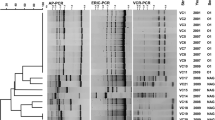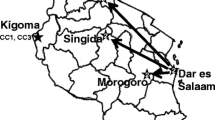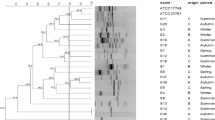Abstract
Sequence analysis of dnaE, hlyA, and asd housekeeping genes were used to determine the genetic relatedness of our collection of Vibrio cholerae isolated from patients and surface waters over a 5-year period in Iran. The results showed 41, 17, and 9 variable sites throughout the sequenced fragments of dnaE (837 bp), hlyA (495 bp), and asd (295 bp), respectively. The results from sequence typing showed that all our clinical isolates were grouped in the same cluster. Eleven genotypes were identified among the environmental isolates. One environmental isolate was found to be in close genetic relatedness with our clinical isolates. One V. cholerae isolate showed a single-locus variant in the dnaE. For each of the studied genetic loci 10, 7, and 7 sequence types were observed for dnaE, hlyA, and asd, respectively. Only asd sequence analysis could make the distinction between the classical and El Tor isolates which emphasizes on selection of housekeeping locus with better discrimination power for analysis of different groups of isolates. Overall, the results indicated that surface waters in Tehran are a pool of non-toxigenic V. cholerae strains which are rarely related to clinical toxigenic isolates. In addition, our results verified that housekeeping gene sequence analysis could be a suitable approach for determination of the relatedness between clinical and environmental V. cholerae isolates.


Similar content being viewed by others
References
Bakhshi B, Barzelighi HM, Adabi M, Lari AR, Pourshafie MR (2009) A molecular survey on virulence associated genotypes of non-O1 non-O139 Vibrio cholerae in aquatic environment of Tehran, Iran. Water Res 43(5):1441–1447. doi:10.1016/j.watres.2008.12.025
Bakhshi B, Pourshafie MR (2009) Assessing clonality of Vibrio cholerae strains isolated during four consecutive years (2004–2007) in Iran. Scand J Infect Dis 41(4):256–262. doi:10.1080/00365540902767049
Bakhshi B, Pourshafie MR, Navabakbar F, Tavakoli A, Shahcheraghi F, Salehi M, Faradjzadegan Z, Zahraei SM (2008) Comparison of distribution of virulence determinants in clinical and environmental isolates of Vibrio cholera. Iran Biomed J 12(3):159–165
Byun R, Elbourne LD, Lan R, Reeves PR (1999) Evolutionary relationships of pathogenic clones of Vibrio cholerae by sequence analysis of four housekeeping genes. Infect Immun 67(3):1116–1124
Cameron DN, Khambaty FM, Wachsmuth IK, Tauxe RV, Barrett TJ (1994) Molecular characterization of Vibrio cholerae O1 strains by pulsed-field gel electrophoresis. J Clin Microbiol 32(7):1685–1690
Chun J, Huq A, Colwell RR (1999) Analysis of 16S-23S rRNA intergenic spacer regions of Vibrio cholerae and Vibrio mimicus. Appl Environ Microbiol 65(5):2202–2208
Dashtbani-Roozbehani A, Bakhshi B, Katouli M, Pourshafie MR (2011) Comparative sequence analysis of recA gene among Vibrio cholerae isolates from Iran with globally reported sequences. Lett Appl Microbiol 53(3):313–323. doi:10.1111/j.1472-765X.2011.03108.x
Farfan M, Minana-Galbis D, Fuste MC, Loren JG (2002) Allelic diversity and population structure in Vibrio cholerae O139 Bengal based on nucleotide sequence analysis. J Bacteriol 184(5):1304–1313
Farfan M, Minana D, Fuste MC, Loren JG (2000) Genetic relationships between clinical and environmental Vibrio cholerae isolates based on multilocus enzyme electrophoresis. Microbiology 146:2613–2626
Feil EJ, Smith JM, Enright MC, Spratt BG (2000) Estimating recombinational parameters in Streptococcus pneumoniae from multilocus sequence typing data. Genetics 154(4):1439–1450
Garg P, Aydanian A, Smith DJ, Glenn MJ, Nair GB, Stine OC (2003) Molecular epidemiology of O139 Vibrio cholerae: mutation, lateral gene transfer, and founder flush. Emerg Infect Dis 9(7):810–814
Ghosh R, Nair GB, Tang L, Morris JG, Sharma NC, Ballal M, Garg P, Ramamurthy T, Stine OC (2008) Epidemiological study of Vibrio cholerae using variable number of tandem repeats. FEMS Microbiol Lett 288(2):196–201
Heidelberg JF, Eisen JA, Nelson WC, Clayton RA, Gwinn ML, Dodson RJ, Haft DH, Hickey EK, Peterson JD et al (2000) DNA sequence of both chromosomes of the cholera pathogen Vibrio cholerae. Nature 406(6795):477–483
Karaolis DK, Lan R, Reeves PR (1995) The sixth and seventh cholera pandemics are due to independent clones separately derived from environmental, nontoxigenic, non-O1 Vibrio cholerae. J Bacteriol 177(11):3191–3198
Labbate M, Boucher Y, Joss MJ, Michael CA, Gillings MR, Stokes HW (2007) Use of chromosomal integron arrays as a phylogenetic typing system for Vibrio cholerae pandemic strains. Microbiology 153:1488–1498
Mohapatra SS, Ramachandran D, Mantri CK, Colwell RR, Singh DV (2009) Determination of relationships among non-toxigenic Vibrio cholerae O1 biotype El Tor strains from housekeeping gene sequences and ribotype patterns. Res Microbiol 160(1):57–62
O’Shea YA, Reen FJ, Quirke AM, Boyd EF (2004) Evolutionary genetic analysis of the emergence of epidemic Vibrio cholerae isolates on the basis of comparative nucleotide sequence analysis and multilocus virulence gene profiles. J Clin Microbiol 42(10):4657–4671
Popovic T, Bopp C, Olsvik O, Wachsmuth K (1993) Epidemiologic application of a standardized ribotype scheme for Vibrio cholerae O1. J Clin Microbiol 31(9):2474–2482
Shangkuan YH, Tsao CM, Lin HC (1997) Comparison of Vibrio cholerae O1 isolates by polymerase chain reaction fingerprinting and ribotyping. J Med Microbiol 46(11):941–948
Singh DV, Matte MH, Matte GR, Jiang S, Sabeena F, Shukla BN, Sanyal SC, Huq A, Colwell RR (2001) Molecular analysis of Vibrio cholerae O1, O139, non-O1, and non-O139 strains: clonal relationships between clinical and environmental isolates. Appl Environ Microbiol 67(2):910–921
Spratt BG, Maiden MC (1999) Bacterial population genetics, evolution and epidemiology. Philos Trans R Soc Lond B Biol Sci 354(1384):701–710
Tamura K, Dudley J, Nei M, Kumar S (2007) MEGA4: Molecular Evolutionary Genetics Analysis (MEGA) software version 4.0. Mol Biol Evol 24:1596–1599
Thompson FL, Gevers D, Thompson CC, Dawyndt P, Naser S, Hoste B, Munn CB, Swings J (2005) Phylogeny and molecular identification of vibrios on the basis of multilocus sequence analysis. Appl Environ Microbiol 71(9):5107–5115
Acknowledgments
The study was funded by Pasteur Institute of Iran Grant numbers 170 and 312.
Author information
Authors and Affiliations
Corresponding author
Rights and permissions
About this article
Cite this article
Dashtbani-Roozbehani, A., Bakhshi, B. & Pourshafie, M.R. Genetic Relatedness of Clinical and Environmental Vibrio cholerae Isolates Based on Triple Housekeeping Gene Analysis. Curr Microbiol 67, 15–20 (2013). https://doi.org/10.1007/s00284-013-0324-7
Received:
Accepted:
Published:
Issue Date:
DOI: https://doi.org/10.1007/s00284-013-0324-7




